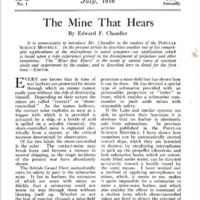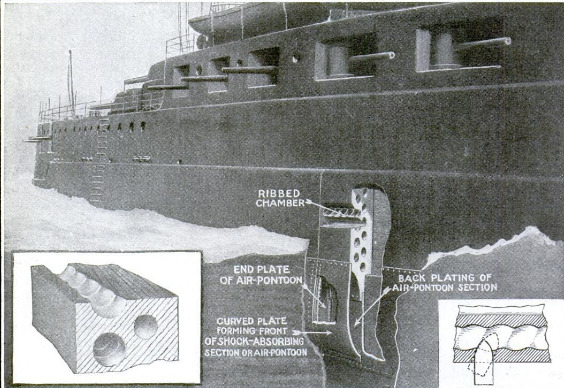Protecting a Battleship with a Belt of Air
Item
-
Title (Dublin Core)
-
Protecting a Battleship with a Belt of Air
-
Article Title and/or Image Caption (Dublin Core)
-
Protecting a Battleship with a Belt of Air
-
extracted text (Extract Text)
-
READ the accounts of the battles
fought off Heligoland and the
Falkland Islands, in which ships
protected by heavy side armor were sunk
by gun fire at ranges of five miles and the
question must occur: What is the good
of armor? If twelve and more inches of
steel can be penetrated by the fifteen-
inch guns of a British battle-cruiser at
distances of miles it would seem as if
victory in sea engagements is a matter of
hitting power rather than of protection.
That armor of some kind is necessary
would follow from the fact that naval
architects are very close students of
naval history and that they promptly
apply in the construction of fighting
ships the lessons taught on the proving-
grounds and in battle. That the heavy
gun seems for the time being to have
gained the ascendency over armor is
proved by the fact that in battle-cruisers
high speed and enormous striking power
are considered more important than
steel sides; for the armor belt of a
battle-cruiser is only twelve inches—
hardly sufficient protection against any-
thing but projectiles of low caliber and
low striking energy.
Inspired by these considerations, Louis
Gathmann, whose experiments in hurling
high explosives against armor on proving-
grounds attracted much attention some
sixteen years ago, has invented an en-
tirely new system of armor protection
which deserves consideration. His ob-
ject is to obtain not only protection, but
lightness; for the heavier the armor of a
ship the fewer must her guns be or the
weaker her engines on a given displace-
ment.
In carrying out his ideas Mr. Gath-
mann would provide a ship with a cham-
bered shell-resisting. section and with a
shock-absorbing section, the first above
the second, as the accompanying illus-
tration shows. The chambers of the
first or shell-resisting section are really
horizontal tubes, the front series of
which are spirally ribbed. ‘Should a
projectile penetrate the hard face of the
armor,” says Mr. Gathmann, “it would
force its way
through the line of
least resistance,
and thereby glance
upward, down-
ward or sideward
as the case may
be, turning or
tilting the projec-
tile, thereby
destroying its
penetrating power;
such shells may
fracture or explode,
but without pene-
trating the armor.”
A fifteen-inch
shell carrying high
explosive generates
gases on exploding
which exert tre-
mendous pressure. That pressure must
be absorbed, or else it may breach
the ship below the armor belt. So,
Mr. Gathmann attaches to the lower
edge of his chambered belt a series of air
chambers or pontoons, each independent
of the other.
Study the illustration which accom-
panies this article and you will see that
this shock-absorbing section consists of
five walls: a downwardly-extending
portion of the armor belt; a rear plate
to which that downwardly-extending
portion is bolted; a curved front plate,
and two end plates to enclose the
pontoon or chamber.
The pontoons seem flimsy, and in
reality they are. But they are intended
to be destroyed. The pressure of the
gases from a huge shell will disrupt one,
two, perhaps three shock-absorbing or
pontoon sections, but the rest will re-
main intact. The air within the cham-
ber will have a cushioning effect. Water
will rush into the compartment, but the
pantoons will still remain in place.
-
Contributor (Dublin Core)
-
Louis Gathmann (inventor)
-
Language (Dublin Core)
-
eng
-
Date Issued (Dublin Core)
-
1916-07
-
pages (Bibliographic Ontology)
-
18-19
-
Rights (Dublin Core)
-
Public Domain (Google digitized)
-
Archived by (Dublin Core)
-
Filippo Valle
-
Alberto Bordignon (Supervisor)
 Popular Science Monthly, v. 89, n. 1, 1916
Popular Science Monthly, v. 89, n. 1, 1916



